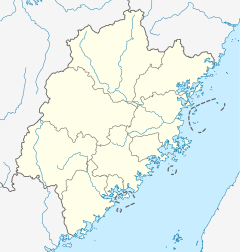Yongquan Temple (Fuzhou)
| Yongquan Temple | |
|---|---|
涌泉寺 | |
| Country | China |
| Geographic coordinates | 26°03′19″N 119°23′42″E / 26.055338°N 119.395037°E |
| Architecture | |
| Style | Chinese architecture |
| Date established | 783 |
| Completed | 1983 (reconstruction) |
Yongquan Temple (
History
Tang dynasty
Yongquan Temple was first built in 783, in the reign of Emperor Dezong of the Tang dynasty (618–907), it initially called "Huayan Temple" (华严寺).
Since
Five Dynasties and Ten Kingdoms
In 908, under the
Song dynasty
In the
Ming dynasty
In 1407, in the Yongle era (1402–1424) of the Ming dynasty (1368–1644), the temple was renamed "Yongquan Temple" (涌泉寺).Yongquan Temple went through two fires and several rebuilds, including the catastrophic fire in 1408 and the disastrous fire in 1542.[2] The
Qing dynasty
Yongquan Temple was refurbished and redecorated by Yuanxian (元贤) in the early Qing dynasty (1644–1911), In 1699, in the 38th year of Kangxi period (1662–1722), Kangxi Emperor inscribed and honored the name "Yongquan Temple".[2][3]
People's Republic of China
After the founding of the Communist State, the Fujian Provincial Government afforded great protection to the temple.
Yongquan Temple has been classified as a National Key Buddhist Temple in Han Chinese Area by the State Council of China in 1983.
Architecture
Yongquan Temple is built along the up and down of maintains. The over 25 rooms and halls still maintain the architectural style of the
Mahavira Hall
The
Pottery Pagodas of Thousand Buddha
A pair of Pottery Pagoda of Thousand Buddha are placed in the temple. They were made in 1082 in the Song dynasty (960–1279). The 6.83-metre (22.4 ft) pagodas was octagonal with nine stories. It is composed of a pagoda base and a dense-eave body. The base were engraved patterns of various flying phoenixes, lotuses, Hercules, monsters, etc. Over 1,078 exquisite niches with small statues of Buddha are carved on the body of the pagoda.[5][3]
National Treasures
Bronze bell
A bronze bell was cast in the 18th century during the Qing dynasty (1644–1911) weighting 2,000-kilogram (4,400 lb). Outside the bell carved 6,372 words of Diamond Sutra.
Avatamsaka Sutra
Over ten sets of
References
- ^ “闽刹之冠”鼓山涌泉寺 藏在深山仿若世外桃源(组图). 163.com (in Chinese). 3 December 2015.
- ^ a b c d Zhang Yuhuan (2012), p. 192.
- ^ a b c d e Wang Xintao (28 October 2013). 鼓山涌泉寺布局溯源 云水深处清净地. iFeng (in Chinese).
- ^ Zhang Yuhuan (2012), p. 192–193.
- ^ a b Zhang Yuhuan (2012), p. 193.
Bibliography
- Zhang Yuhuan (2012). "The Largest Buddhist Temple in Southeastern China: Yongquan Temple on Mount Gu" 《东南第一大丛林:鼓山涌泉寺》. 《图解中国著名佛教寺院》 [Illustration of Famous Buddhist Temples in China] (in Chinese). Beijing: Contemporary China Publishing House. ISBN 978-7-5154-0135-5.


